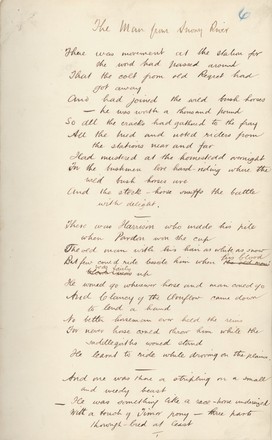
The Man from Snowy River and other verses
1895
Manuscript
Acquired from Angus & Robertson, 1933
MLMSS 314 / 195 (A 1909)
Manuscript
Acquired from Angus & Robertson, 1933
MLMSS 314 / 195 (A 1909)
First published in the Bulletin in April 1890, Banjo Patterson‘s poem ‘The Man from Snowy River’ was an instant success. While Paterson had no illusions about his writing skills – ‘Scant in their worth’, he said, ‘their merits indeed but slight’* – the poem tapped into a strengthening surge of nationalism in the lead-up to Federation in 1901.
Paterson's verse celebrated a rugged, irreverent and masculine spirit that turned away from the city to a wild and idealised bush heartland. Along with Dorothea Mackellar’s ‘My Country’ and the paintings of artists such as Arthur Streeton and Tom Roberts, Paterson’s ‘The Man from Snowy River’ and other writings helped popularise a distinctive but highly selective Australian identity that would maintain a powerful hold for generations to come.
Paterson republished the poem in 1895 in his first book The Man from Snowy River and other verses. The volume on display is an incomplete manuscript of the book. Along with `The Man from Snowy River' and other poems written in Paterson's hand, it contains typescript versions of poems, cuttings from the Bulletin and various printed extracts. It was later bound by the publisher George Robertson of Angus & Robertson.


 Back to list
Back to list